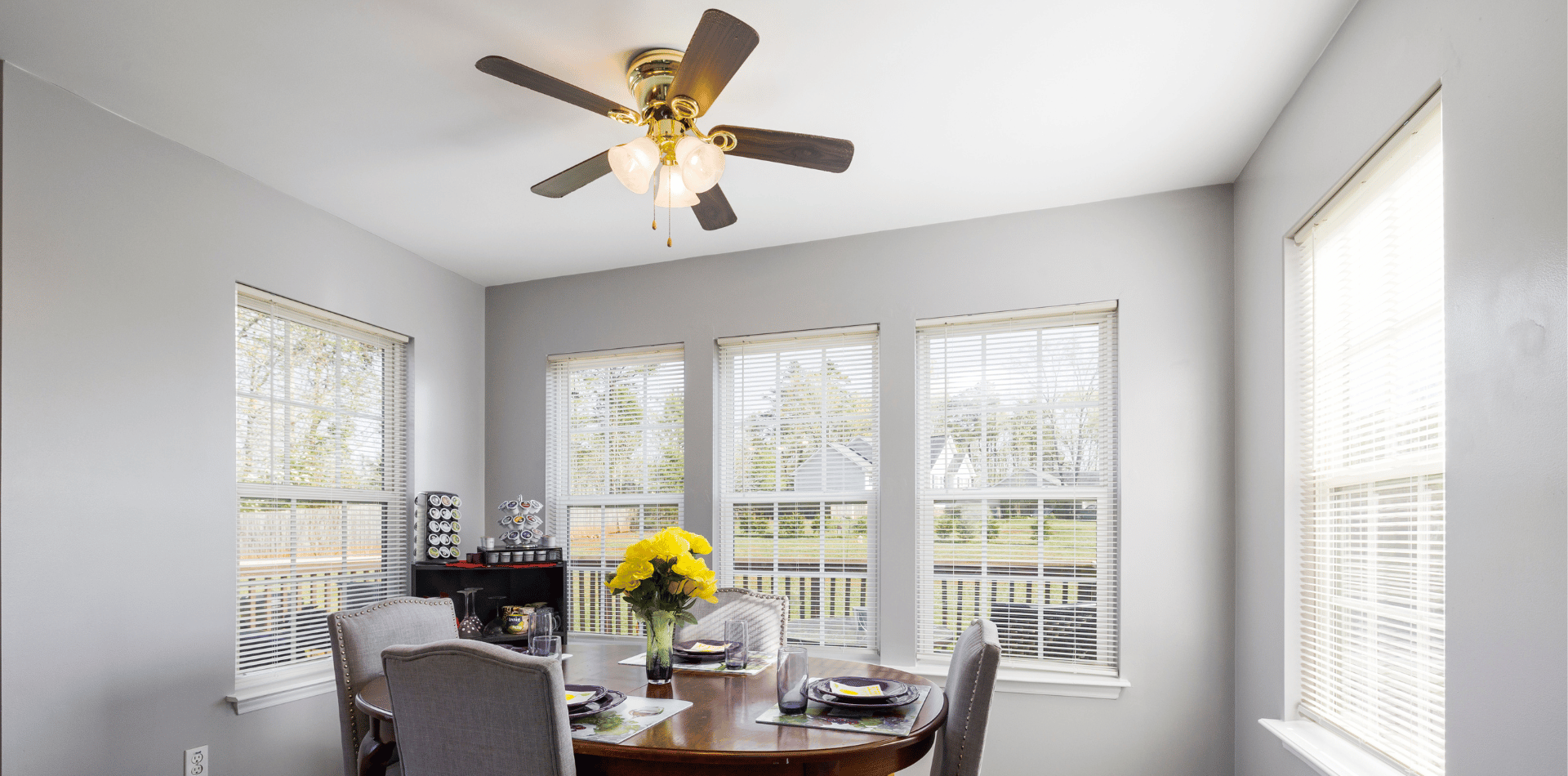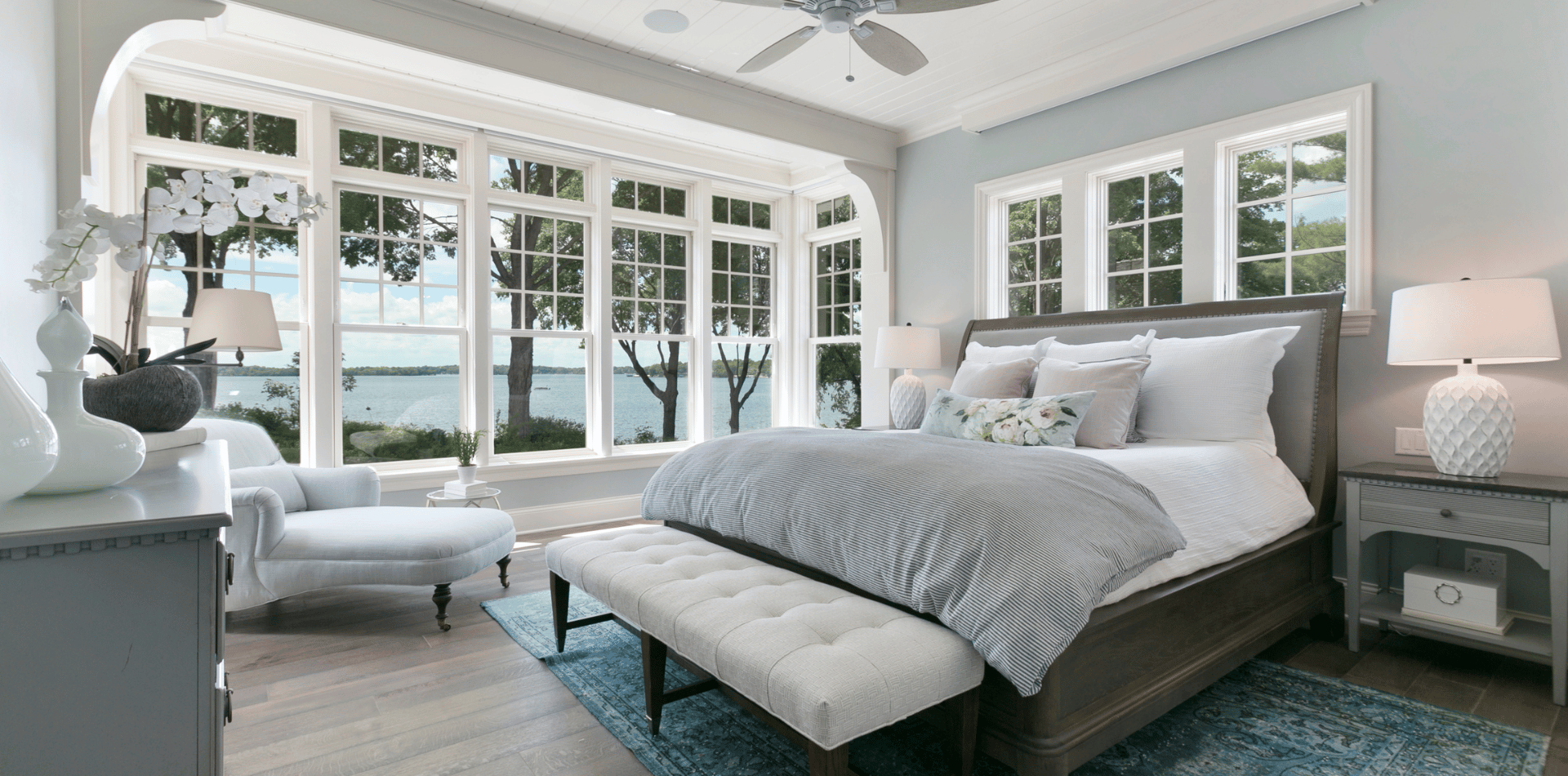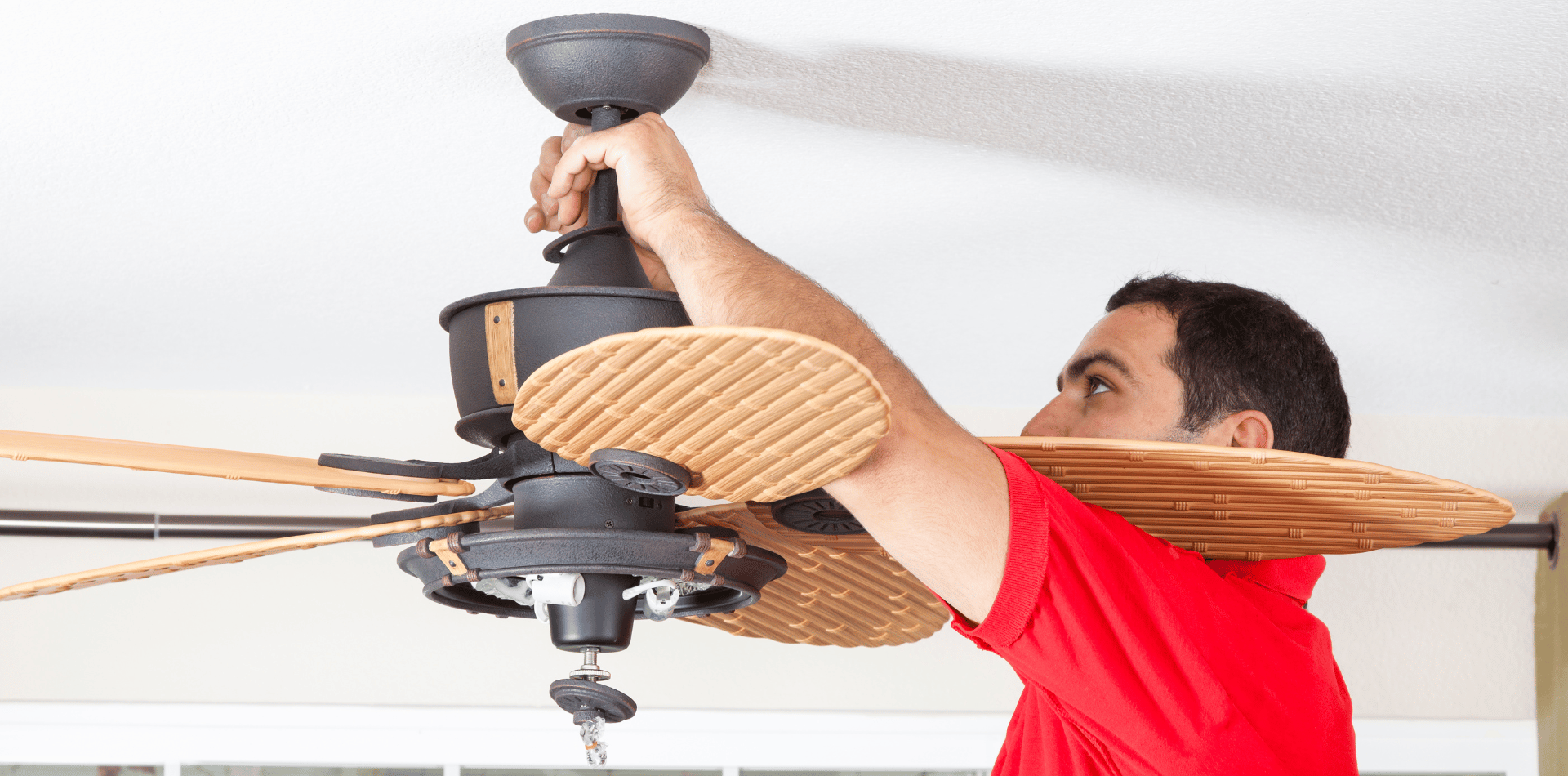Benefits of Installing Ceiling Fans in Your Home
The Cooling Effect: Benefits of Installing Ceiling Fans in Your Home

When it comes to maintaining a comfortable atmosphere in your home, ceiling fans are a timeless solution that offer a plethora of benefits beyond simple aesthetics.
Not only can they add a touch of elegance and style to any room, but their functional advantages extend from improving air circulation to reducing energy costs.
Let’s look into the numerous benefits of installing ceiling fans in your home.
Energy Efficiency and Cost Savings
One of the primary reasons homeowners opt for ceiling fans is their outstanding energy efficiency and the subsequent cost savings. Unlike air conditioning units, which can be heavy on power consumption and high on maintenance, ceiling fans present a more economical and environmentally friendly cooling solution. Let’s delve deeper into how ceiling fans contribute to energy efficiency and cost savings.
Reduced Electricity Consumption
Ceiling fans are engineered to consume significantly less electricity compared to traditional air conditioning systems. On average, a ceiling fan utilises about the same amount of power as a 60-100 watt light bulb, which is substantially lower than the several kilowatts required by air conditioners. This reduced energy consumption makes ceiling fans an ideal choice for those looking to cut down on electricity usage and embrace a more sustainable lifestyle.
Optimal Air Circulation
The mechanism behind ceiling fans is straightforward yet effective: by rotating at different speeds, they create a draft throughout the room. This circulation ensures that cool air is evenly distributed, making the entire space feel cooler without the need to drastically lower the room's temperature. This optimal air circulation means that you can set the thermostat on your air conditioning unit a few degrees higher, which significantly reduces the energy it consumes. Over time, this reduced demand on your air conditioning system can lead to considerable savings on your energy bills.
Strategic Use with Air Conditioning
For those days when air conditioning is a must, ceiling fans can still play a pivotal role in energy efficiency. When used in conjunction with an air conditioner, ceiling fans can spread the cooled air more rapidly and efficiently throughout the room. This synergy allows you to set the air conditioner at a higher temperature than you would typically find comfortable, as the fan helps to maintain a cool and pleasant environment. This strategy can lead to a substantial reduction in energy consumption, as the air conditioner does not have to work as hard to cool the room.
Financial Savings
The initial investment in a ceiling fan is generally lower than that for air conditioning units, and the installation process is less intrusive. The operational costs are also significantly lower; ceiling fans cost mere pennies per hour to run, a fraction of what air conditioning systems consume. This disparity in operating costs can lead to significant financial savings, particularly during the hot summer months when cooling systems tend to run continuously.
Temperature Regulation and Thermostat Settings
The psychological effect of moving air can make a room feel up to 8 degrees cooler than the actual temperature, allowing homeowners to raise their thermostat setting without compromising comfort. This adjustment, known as the "wind chill effect," not only contributes to a more comfortable living environment but also to a noticeable reduction in energy use. For every degree you raise your thermostat, you can save between 2% and 3% on your cooling costs. Over the course of a season, this can translate into substantial savings.
Environmental Impact
By opting for ceiling fans over air conditioners, or by using them together more strategically, you're also making a choice that benefits the environment. Lower energy consumption translates to reduced greenhouse gas emissions and a smaller carbon footprint. In an era where climate change is a significant concern, making energy-efficient choices like this can have a meaningful impact.
The benefits of installing ceiling fans extend beyond just aesthetics and comfort. They are a practical and efficient way to reduce energy consumption, lower utility bills, and contribute to a more sustainable planet.
By understanding and leveraging the energy-efficient features of ceiling fans, homeowners can enjoy a cooler, more comfortable home environment while saving money and reducing their environmental impact.
Year-Round Comfort
Ceiling fans are often associated with the warm, balmy days of summer, but their utility spans all four seasons, contributing significantly to a home's comfort level throughout the year.
The design and functionality of modern ceiling fans take into account the changing temperatures of each season, ensuring they offer year-round benefits.
Here’s a closer look at how ceiling fans can be used to enhance comfort no matter the time of year.
Cooling Effect in Summer
In the hot summer months, ceiling fans prove their worth by providing a significant cooling effect in indoor spaces. When set to rotate anticlockwise at a higher speed, the blades of a ceiling fan push cool air downwards. This creates a breeze effect that helps evaporate sweat and lower the body's temperature, making the room feel cooler than it actually is.
This direct cooling method allows residents to feel comfortable even when the thermostat is set at a higher temperature, leading to energy savings and reduced strain on air conditioning systems.
Warmth Distribution in Winter
Conversely, during the colder months, ceiling fans can be adjusted to rotate clockwise at a lower speed. This setting pulls cool air up towards the ceiling and pushes the warmer air, which naturally rises and accumulates near the ceiling, down along the walls and back into the living space. This gentle updraft redistributes warm air evenly throughout the room, eliminating cold spots and drafts.
By improving the efficiency of your home’s heating system, ceiling fans can reduce the need for excessive heating and lower overall energy consumption.
Transitional Comfort in Spring and Autumn
During the milder seasons of spring and autumn, the weather can be unpredictable, with days fluctuating between being slightly warm and a bit too cool. Ceiling fans can be particularly beneficial during these times, offering a moderate and comfortable breeze that can help regulate the room's temperature without the need for heating or cooling systems.
On mild days, simply using a ceiling fan can be sufficient to maintain comfort, saving energy and providing a pleasant living environment.
Improved Air Quality and Circulation
Beyond temperature regulation, ceiling fans contribute to improved air quality and circulation year-round.
Continuous movement of air prevents the buildup of dust particles, allergens, and odours, ensuring a fresher and healthier living environment.
This circulation is crucial, especially in rooms that lack adequate ventilation or where windows cannot be opened due to seasonal allergies or outdoor temperatures.
Versatility and Convenience
Modern ceiling fans come with a variety of features that enhance their year-round usability.
Remote controls, programmable timers, and variable speed settings allow users to easily adjust the fan’s operation to suit their immediate needs, whether it’s a gentle breeze during a spring afternoon or stronger air movement on a hot summer day.
The reversible motor function is often accessible via remote control, making the transition between summer and winter settings seamless and convenient.
The year-round utility of ceiling fans makes them an indispensable feature of any home.
Not only do they enhance comfort and improve air quality, but they also adapt to the changing seasons, providing cost-effective and energy-efficient solutions to temperature regulation. By understanding how to optimise the use of ceiling fans throughout the year, homeowners can enjoy a comfortable, welcoming environment no matter the weather outside.

Enhanced Air Circulation and Indoor Air Quality
Maintaining a fresh and healthy indoor environment is crucial for comfort and health, particularly in homes with limited ventilation or in areas prone to high levels of pollutants.
Ceiling fans play a pivotal role in enhancing the quality of indoor air through improved circulation and ventilation.
Here’s how ceiling fans can contribute to a healthier living space.
Continuous Air Movement
The primary function of a ceiling fan is to circulate air within a room, which is fundamental for maintaining an environment that feels fresh and is healthier to breathe.
By continuously moving air, ceiling fans ensure that the air does not become stagnant. Stagnant air can lead to the accumulation of moisture, which can foster mould growth and increase the concentration of indoor pollutants.
The constant air movement provided by ceiling fans helps prevent these issues, promoting a cleaner and more comfortable environment.
Reduction of Pollutants and Allergens
Indoor air quality can be significantly impacted by the presence of dust, pollen, pet dander, and other allergens.
These particles can accumulate on surfaces and in the air, posing health risks, especially to individuals with allergies, asthma, or other respiratory conditions. Ceiling fans help by dispersing these particles, preventing them from settling and reducing their concentration in the indoor air. While not a substitute for regular cleaning and air purification, the use of ceiling fans can complement these activities by ensuring that air continuously moves, making the environment less hospitable for allergens and pollutants.
Improved Ventilation
In many homes, especially older ones, natural ventilation may not be sufficient to maintain good indoor air quality.
Ceiling fans can assist in this aspect by improving air exchange with the outside when windows are open, facilitating the removal of stale indoor air and the introduction of fresh outdoor air. This exchange is crucial for diluting indoor pollutants and reducing indoor humidity levels, which, in turn, helps to control allergens such as dust mites and mold spores.
Synergy with Air Conditioning and Heating
Ceiling fans can work in tandem with air conditioning and heating systems to enhance indoor air quality. By promoting better air circulation, ceiling fans help distribute conditioned air more evenly throughout a room or home. This not only makes heating and cooling systems more efficient but also prevents the buildup of dust and other pollutants by ensuring that they are continuously filtered and not allowed to settle in one area.
Support for Health and Well-being
The benefits of improved air circulation extend beyond just physical health.
Good indoor air quality can also have a significant positive impact on mental well-being and cognitive function. Fresh, clean air can help reduce headaches, fatigue, and concentration problems, contributing to a more pleasant and productive environment.
Energy Efficiency
While improving indoor air quality, ceiling fans maintain energy efficiency, unlike many air purifiers and conditioning systems that can consume a significant amount of electricity. By providing a cooling effect and enhancing the efficiency of existing HVAC systems, ceiling fans allow for lower thermostat settings and reduced reliance on energy-intensive appliances, leading to lower energy consumption and a smaller environmental footprint.
The role of ceiling fans in enhancing air circulation and indoor air quality cannot be overstated.
They provide an energy-efficient solution to improve the freshness and healthiness of indoor environments. By reducing the accumulation of pollutants and allergens and promoting better ventilation, ceiling fans contribute significantly to a more comfortable and healthier living space.
Integrating ceiling fans into your home’s design is not just a matter of comfort but also a step towards a healthier, more sustainable lifestyle.
Versatile Design and Aesthetic Appeal
Ceiling fans have transcended their original, purely utilitarian purpose to become significant design elements within interior spaces. With advancements in design and technology, ceiling fans now offer a multitude of styles, materials, and features, allowing them to complement any decor theme and add aesthetic value to a room.
Here's how they can enhance the visual appeal of your home.
Wide Range of Styles
The variety of ceiling fan designs available today is vast, catering to an array of aesthetic preferences and interior themes.
From minimalist and contemporary models that feature sleek lines and subtle finishes to more traditional designs adorned with wood finishes and classical detailing, there's a ceiling fan for every style. Industrial designs with metal elements and exposed hardware can add a raw, edgy vibe to urban lofts or modern living spaces, while coastal designs with light colours and natural materials can evoke a sense of calm and relaxation, perfect for beach houses or sunrooms.
Customisable Features
Modern ceiling fans offer an array of customisable features that enhance their design flexibility.
Blade lengths and finishes can vary widely, allowing homeowners to choose the perfect size and colour to fit their room's scale and style. Lighting is another customisable feature, with options ranging from subtle, integrated LED lights to more elaborate, chandelier-like fixtures that can serve as the room's primary light source. These customisable features ensure that a ceiling fan can serve not only as a functional appliance but also as a key element of a room's design.
Material and Colour Choices
The materials and colours of ceiling fans have evolved, offering more choices to complement any decor.
Blades can be found in a range of materials, including wood, plastic, metal, and even sustainable options like bamboo. They can also feature a variety of finishes, from matte and glossy to brushed or distressed, allowing for perfect integration into your existing decor. The fan's body and motor casing can also vary in colour and finish, providing endless possibilities for matching or accenting the colour scheme of a room.
Integration into Home Decor
A well-chosen ceiling fan can integrate seamlessly into your home decor, enhancing the room's overall aesthetic.
For a cohesive look, select a fan whose style and colour align with your existing furnishings and colour palette. Alternatively, a ceiling fan can serve as a statement piece, adding a dramatic focal point to a room with its design, size, or colour. Whether blending in or standing out, the right ceiling fan can complete a room's look while providing the added benefits of improved air circulation and comfort.
Technology and Innovation
Technological advancements have not only improved the functionality of ceiling fans but also their design appeal.
Many modern fans are equipped with slimline motors and hidden blades, offering a sleek and unobtrusive look. Smart ceiling fans can be integrated into home automation systems, allowing for remote control of the fan's speed, direction, and lighting, which adds a layer of convenience and modernity to the fan's design.
The versatility in design and aesthetic appeal of ceiling fans today makes them a significant consideration in home decor.
No longer just practical tools for air circulation, ceiling fans have become integral components of interior design, capable of enhancing the style and ambiance of a space.
With the wide range of designs, materials, and customisable features available, selecting the right ceiling fan provides an opportunity to not only improve comfort but also to express personal style and enhance the aesthetic appeal of your home.
Lighting and Additional Features
The modern ceiling fan is far more than just a device for air circulation; it's a multi-functional fixture that can significantly enhance the functionality and comfort of any living space. The integration of lighting and advanced technological features into ceiling fans represents a leap forward in convenience and efficiency.
These advancements can add value and ease to everyday living.
Integrated Lighting Solutions
Ceiling fans equipped with lighting fixtures serve a dual purpose, offering both illumination and air circulation from a single installation point.
This integration is particularly beneficial in spaces where ceiling real estate is limited, such as in smaller rooms or apartments.
The designs of these lighting fixtures vary widely, from subtle, recessed lights that provide a soft glow to elaborate, decorative lamps that can serve as a room’s central light source. With options ranging from LED lights known for their energy efficiency and longevity, to more traditional bulb types, there's a lighting style to match any decor and preference.
The lighting component in ceiling fans also allows for customisation of ambiance. Dimmable lights, for example, enable users to adjust the brightness to suit different moods and occasions, from bright illumination for reading or tasks to softer lighting for relaxing evenings. This feature, combined with the fan's functionality, offers a perfect blend of practicality and atmosphere.
Remote Control and Convenience Features
Modern ceiling fans often come equipped with remote controls, making it easy to adjust the fan speed, change lighting levels, and even reverse the direction of the blades without needing to reach for a wall switch or pull a cord. This convenience is particularly appreciated in rooms with high ceilings or in bedroom settings where ease of use contributes to comfort and relaxation.
Some fans are also equipped with programmable timers, allowing users to set the fan or light to turn on or off at specific times. This can be useful for waking up to a gently lit room, or for ensuring a cool, comfortable environment when returning home, all while saving energy by not running the fan when it's not needed.
Smart Home Integration
As smart home technology becomes increasingly prevalent, many ceiling fans now offer integration with home automation systems. This connectivity allows for control of the fan and lighting through smartphone apps, voice commands via smart speakers, or through other smart home devices. You can create customised "scenes" or routines — for example, a "goodnight" scene that dims the lights and sets the fan to a gentle speed, all with a single command.
Smart ceiling fans can also be integrated with other home systems for enhanced functionality. For example, a fan could be set to automatically turn on when a room reaches a certain temperature, or to operate in conjunction with window sensors, turning off when windows are open to conserve energy.
Environmental Sensors and Adaptive Technology
Some of the latest ceiling fan models are equipped with environmental sensors that detect room conditions such as temperature and humidity. These fans can adjust their speed automatically to maintain optimal comfort levels without any input from the user. This adaptive technology ensures efficient operation, reducing energy consumption by not overcooling or overheating the room.
The integration of lighting and advanced features into ceiling fans underscores the evolution of this traditional fixture into a versatile, modern home appliance.
By combining air circulation, illumination, and smart technology, these enhanced ceiling fans offer a level of convenience, comfort, and energy efficiency that complements today's lifestyles.
Whether through simple remote controls or sophisticated smart home integration, ceiling fans have become an integral part of the connected, comfortable, and energy-efficient home.

Easy Installation and Low Maintenance
Ceiling fans have become a staple in homes not only for their efficiency and aesthetic appeal but also for their user-friendly installation and maintenance processes.
This ease of handling enhances their appeal to homeowners looking for functional upgrades without the hassle.
Here's some of the aspects that make ceiling fans a straightforward choice for home improvement.
Simplified Installation Process
The notion that installing a ceiling fan is a complex and tedious task is a common misconception.
In reality, the installation process can be straightforward, particularly if you are replacing an existing light fixture. In such cases, the necessary wiring is already in place, and the main task involves mounting the fan.
Most ceiling fans come with a detailed instruction manual and all the necessary hardware for installation, which can typically be completed within a few hours.
For those unfamiliar with electrical installations, it might be advisable to hire a professional to ensure safety and correct installation. However, for the average DIY enthusiast, installing a ceiling fan is a manageable project.
It involves assembling the fan, securing the mounting bracket, connecting the wires, and attaching the fan to the ceiling—all tasks that can be done with basic tools and a bit of patience.
Minimal Maintenance Requirements
Once installed, ceiling fans require very little maintenance, making them a low-hassle addition to any room.
Regular maintenance typically involves:
- Dusting: Like any household fixture, ceiling fans accumulate dust over time. Regular dusting of the blades and light fixtures helps maintain their appearance and functionality. This can be done with a soft cloth or a duster, and for higher ceilings, an extendable duster can reach without the need for a ladder.
- Tightening Screws: Over time, the screws on the fan blades and motor can become loose due to the fan's vibration. Periodically checking and tightening these screws can prevent wobbling and noise, ensuring the fan operates smoothly.
- Lubrication: While many modern fans are designed to be "maintenance-free," some models may require occasional lubrication to keep the motor running smoothly. This typically involves adding a few drops of light machine oil to the motor, a simple task that can extend the life of your fan.
- Balance: If a fan begins to wobble, it may need to be balanced. Balancing kits, often included with the fan or available at hardware stores, can easily correct this issue. The process involves adjusting the weights on the fan blades until the wobble stops, ensuring quiet, efficient operation.
Versatility and Adaptability
Ceiling fans are designed to fit a variety of spaces, both in terms of size and style.
This adaptability extends to their installation process, which accommodates different ceiling heights and types. For example, fans can be mounted directly to the ceiling in rooms with low ceilings, or they can be installed with downrods in rooms with high ceilings or angled ceilings, ensuring optimal airflow and performance.
The easy installation and low maintenance of ceiling fans make them an appealing choice for homeowners looking to enhance their living spaces.
With just a few tools and a little effort, you can enjoy the year-round benefits of a ceiling fan, from improved air circulation and reduced energy costs to added lighting and aesthetic appeal.
The straightforward nature of ceiling fan upkeep, requiring only minimal cleaning and occasional checks, ensures that they remain an efficient, functional, and attractive part of your home with minimal effort.
Installing ceiling fans in your home offers numerous benefits, from energy savings and improved air quality to aesthetic appeal and year-round comfort.
With the wide variety of designs and features available, there’s a ceiling fan to suit every taste and need.
By choosing the right ceiling fans for your home, you can enjoy a more comfortable, healthier, and more stylish living environment while also reducing your energy costs.
You might also like





